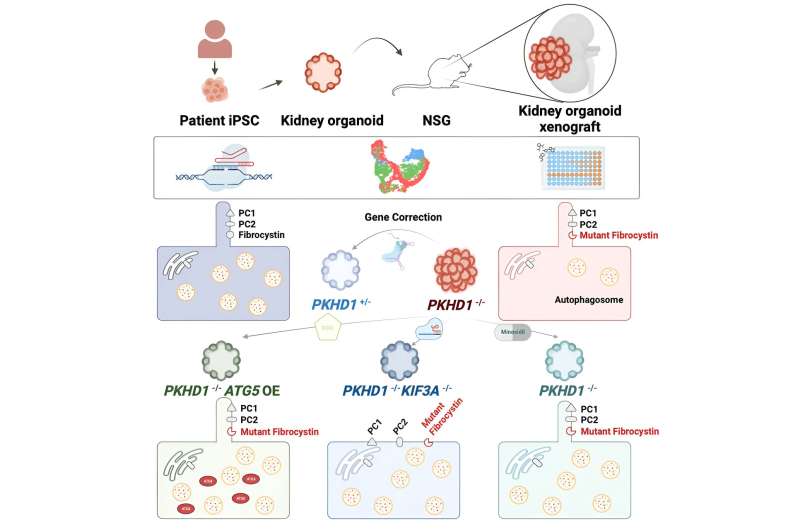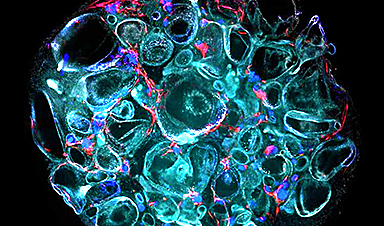Scientists at Nanyang Technological University, Singapore (NTU Singapore) have successfully grown ‘mini kidneys’ in the lab and grafted them into live mice, revealing new insights into the metabolic defects and a potential therapy for polycystic kidney disease.
“Mini kidneys,” or kidney organoids, are kidney-like structures grown in the lab using stem cells. In the study led by NTU’s Lee Kong Chian School of Medicine (LKCMedicine), researchers grew the organoids using skin cells derived from patients with polycystic kidney disease (PKD), a prevalent form of genetic condition that affects 1 in 1,000 individuals across all ethnicities.
People with PKD often progress to end-stage kidney disease between their 50s and 60s, with the standard treatment options available being dialysis or a kidney transplant. However, dialysis significantly compromises a patient’s quality of life, while a transplanted kidney can be challenging to acquire. One other option is the Food and Drug Administration (FDA) approved drug Tolvaptan, which is very costly and has severe side effects on the liver.
To address the need for more effective treatment for PKD patients, the NTU research team sought to better understand the disease by engrafting their newly developed mini kidneys into mice.
Previous studies were conducted on mini kidneys grown in a dish, which could only partly mimic the kidney structure and function. The NTU scientists engrafted the mini kidneys into live mice to comprehensively replicate the pathological features of kidney disease, including blood flow, fluid movement (tubular fluid) and cellular communication with other organs.
Lead investigator Assistant Professor Xia Yun at LKCMedicine said, “Engrafting the kidney organoid in mice provided us with a physiologically sophisticated approach to studying polycystic kidney disease as we were able to successfully emulate critical disease characteristics similar to those observed in human kidney patients.”
Critical disease characteristics included abnormalities like the spontaneous formation of cysts in the kidneys and the subsequent damage to its tiny tubes.

In their study, reported in the journal Cell Stem Cell, the NTU research team said that they believed their engrafted mini kidneys were high quality because cysts sustained without extra stress stimulation or chemicals, even after they were removed from the live mice for further investigations in a dish. In contrast, previous kidney organoids grown in a dish cannot form cysts without stress stimulation.
Co-investigator Assistant Professor Foo Jia Nee at LKCMedicine said, “The similarity between the disease manifestation observed in our engrafted mini kidney model and the real-life experiences of polycystic kidney disease patients suggest that growing kidney organoids and engrafting them into live mice could be beneficial in studying the disease and a useful tool to test new treatments.”
Metabolic defects in polycystic kidney disease
Scientists have long known that abnormalities in a structure on kidney cells, or the primary cilium, cause cysts to form in kidneys. However, tests to understand the regulatory mechanism and relationship between the primary cilium and cell metabolism (autophagy) in live mice with PKD, have not been possible until now.
By studying the development of PKD in live mice and testing cellular pathways, researchers found evidence that boosting autophagy could reduce the severity of cysts in the mini kidney.
After establishing that boosting autophagy could reduce cysts, the NTU scientists shortlisted 22 drugs known for their effects on cell metabolism and tested them in the lab. Results showed that minoxidil, a clinical drug widely used to cure hypertension and hair loss, effectively reduced cyst formation in the novel mouse model.
Asst Prof Xia Yun said, “Our study has demonstrated how cysts in polycystic diseased kidneys can be reduced by boosting autophagy, suggesting that this could be a promising treatment for PKD. Moreover, the proven clinical safety of minoxidil may allow it to be quickly re-purposed to treat PKD patients in clinic. However, more research will be needed to establish this potential.”
Commenting as an independent expert, Associate Professor Ng Kar Hui, Senior Consultant, Division of Paediatric Nephrology, Dialysis and Renal Transplantation, Department of Paediatrics, Khoo Teck Puat—National University Children’s Medical Institute, National University Hospital, said, “Polycystic kidney disease is one of the biggest causes of chronic kidney diseases among adults. An effective treatment may potentially ameliorate the rising numbers of people with kidney failure in Singapore. The establishment of such models in live organisms brings us one step closer to finding more treatment options.”
In future studies, the NTU team will test the efficacy of minoxidil and adapt the mini kidney models to investigate other burgeoning kidney diseases without a strong genetic underpinning, such as diabetic kidney disease.
More information: Meng Liu et al, Kidney organoid models reveal cilium-autophagy metabolic axis as a therapeutic target for PKD both in vitro and in vivo, Cell Stem Cell (2024). DOI: 10.1016/j.stem.2023.12.003
News
Studies detail high rates of long COVID among healthcare, dental workers
Researchers have estimated approximately 8% of Americas have ever experienced long COVID, or lasting symptoms, following an acute COVID-19 infection. Now two recent international studies suggest that the percentage is much higher among healthcare workers [...]
Melting Arctic Ice May Unleash Ancient Deadly Diseases, Scientists Warn
Melting Arctic ice increases human and animal interactions, raising the risk of infectious disease spread. Researchers urge early intervention and surveillance. Climate change is opening new pathways for the spread of infectious diseases such [...]
Scientists May Have Found a Secret Weapon To Stop Pancreatic Cancer Before It Starts
Researchers at Cold Spring Harbor Laboratory have found that blocking the FGFR2 and EGFR genes can stop early-stage pancreatic cancer from progressing, offering a promising path toward prevention. Pancreatic cancer is expected to become [...]
Breakthrough Drug Restores Vision: Researchers Successfully Reverse Retinal Damage
Blocking the PROX1 protein allowed KAIST researchers to regenerate damaged retinas and restore vision in mice. Vision is one of the most important human senses, yet more than 300 million people around the world are at [...]
Differentiating cancerous and healthy cells through motion analysis
Researchers from Tokyo Metropolitan University have found that the motion of unlabeled cells can be used to tell whether they are cancerous or healthy. They observed malignant fibrosarcoma [...]
This Tiny Cellular Gate Could Be the Key to Curing Cancer – And Regrowing Hair
After more than five decades of mystery, scientists have finally unveiled the detailed structure and function of a long-theorized molecular machine in our mitochondria — the mitochondrial pyruvate carrier. This microscopic gatekeeper controls how [...]
Unlocking Vision’s Secrets: Researchers Reveal 3D Structure of Key Eye Protein
Researchers have uncovered the 3D structure of RBP3, a key protein in vision, revealing how it transports retinoids and fatty acids and how its dysfunction may lead to retinal diseases. Proteins play a critical [...]
5 Key Facts About Nanoplastics and How They Affect the Human Body
Nanoplastics are typically defined as plastic particles smaller than 1000 nanometers. These particles are increasingly being detected in human tissues: they can bypass biological barriers, accumulate in organs, and may influence health in ways [...]
Measles Is Back: Doctors Warn of Dangerous Surge Across the U.S.
Parents are encouraged to contact their pediatrician if their child has been exposed to measles or is showing symptoms. Pediatric infectious disease experts are emphasizing the critical importance of measles vaccination, as the highly [...]
AI at the Speed of Light: How Silicon Photonics Are Reinventing Hardware
A cutting-edge AI acceleration platform powered by light rather than electricity could revolutionize how AI is trained and deployed. Using photonic integrated circuits made from advanced III-V semiconductors, researchers have developed a system that vastly [...]
A Grain of Brain, 523 Million Synapses, Most Complicated Neuroscience Experiment Ever Attempted
A team of over 150 scientists has achieved what once seemed impossible: a complete wiring and activity map of a tiny section of a mammalian brain. This feat, part of the MICrONS Project, rivals [...]
The Secret “Radar” Bacteria Use To Outsmart Their Enemies
A chemical radar allows bacteria to sense and eliminate predators. Investigating how microorganisms communicate deepens our understanding of the complex ecological interactions that shape our environment is an area of key focus for the [...]
Psychologists explore ethical issues associated with human-AI relationships
It's becoming increasingly commonplace for people to develop intimate, long-term relationships with artificial intelligence (AI) technologies. At their extreme, people have "married" their AI companions in non-legally binding ceremonies, and at least two people [...]
When You Lose Weight, Where Does It Actually Go?
Most health professionals lack a clear understanding of how body fat is lost, often subscribing to misconceptions like fat converting to energy or muscle. The truth is, fat is actually broken down into carbon [...]
How Everyday Plastics Quietly Turn Into DNA-Damaging Nanoparticles
The same unique structure that makes plastic so versatile also makes it susceptible to breaking down into harmful micro- and nanoscale particles. The world is saturated with trillions of microscopic and nanoscopic plastic particles, some smaller [...]
AI Outperforms Physicians in Real-World Urgent Care Decisions, Study Finds
The study, conducted at the virtual urgent care clinic Cedars-Sinai Connect in LA, compared recommendations given in about 500 visits of adult patients with relatively common symptoms – respiratory, urinary, eye, vaginal and dental. [...]





















